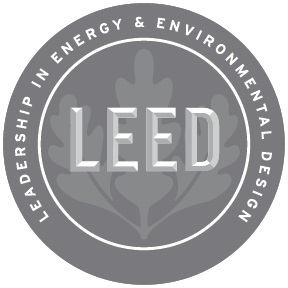
What is LEED?
By Olivia Caron, E.I.T.
 LEED (Leadership in Energy and Environmental Design) is the most popular rating system used for green buildings. It is not required for a building to be LEED certified but it does provide certain advantages including having significantly higher occupancy rates, reduced energy bills and opportunities for tax breaks or other monetary incentives. There are three levels of LEED professional accreditation; a green associate who can contribute expertise to design, operations and maintenance of green buildings, a LEED AP streamlines and approves a building’s certification, and a LEED Fellow is the highest certification and is only given to a few select people who have proven their skill and commitment to the green building field. Team Engineering’s Professional Engineers, John Turner and Nancy Nichols, are both LEED AP certified and Engineer Assistant, Olivia Caron, is a Green Associate. A building can be awarded different levels of licensing approval; Certified, Silver, Gold and Platinum. These levels are based off the number of points a building earns. There are eight categories to earn points in, with a variety of credits within each group. There are prerequisites that must be met for the entire certification and within each category, and then the design team and owner can pick and choose the credits that work best to enhance their building and site. The minimum number of points required to earn a Certified approval is 40 credits.
LEED (Leadership in Energy and Environmental Design) is the most popular rating system used for green buildings. It is not required for a building to be LEED certified but it does provide certain advantages including having significantly higher occupancy rates, reduced energy bills and opportunities for tax breaks or other monetary incentives. There are three levels of LEED professional accreditation; a green associate who can contribute expertise to design, operations and maintenance of green buildings, a LEED AP streamlines and approves a building’s certification, and a LEED Fellow is the highest certification and is only given to a few select people who have proven their skill and commitment to the green building field. Team Engineering’s Professional Engineers, John Turner and Nancy Nichols, are both LEED AP certified and Engineer Assistant, Olivia Caron, is a Green Associate. A building can be awarded different levels of licensing approval; Certified, Silver, Gold and Platinum. These levels are based off the number of points a building earns. There are eight categories to earn points in, with a variety of credits within each group. There are prerequisites that must be met for the entire certification and within each category, and then the design team and owner can pick and choose the credits that work best to enhance their building and site. The minimum number of points required to earn a Certified approval is 40 credits.
The goal of LEED is to meet and enhance the triple bottom line which is people, planet and profit. By doing this, LEED buildings will help improve workspace/living area quality and productivity, reduce carbon footprints, and provide a payback period of as little as a year, among a quantity of other measurable benefits. One element of LEED that is unique and truly allows it to be effective is the Integrative Process which is when everyone involved in the building process meets and plans out the best credits to pursue for points. This ensures the most beneficial credits are met and creates flow between the different design groups as there are many similar credits between categories. This prevents a lot of mistakes from being made or change orders from happening later which keeps prices down. Some examples of credits that can be achieved include increasing building density and decreasing spread, locating the building near public transportation, providing parking spaces for electric cars, increasing sun reflectivity to decrease trapping heat in cities, etc. In total, there are 110 credit options which provides a multitude of options for buildings to find the credits that work best for them. LEED is a growing industry which has the capability to transform the world into a healthier place if enough people take advantage of it.
More Articles From...
| This Category | Architectural Design, Residential Engineering, Structural Design, Structural Engineering |
| This Author | Olivia Caron, E.I.T. |
